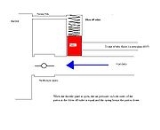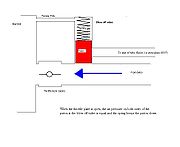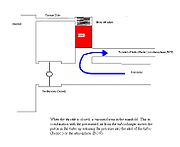
Blowoff valve
Encyclopedia
A blowoff valve or dump valve is a pressure release system present in most turbocharged engines.
Its purpose is to prevent compressor surge, and reduce wear on the turbocharger
and engine. Blowoff valve
s relieve the damaging effects of compressor "surge loading" by allowing the compressed air to vent to atmosphere, making a distinct hissing sound, or recirculated into the intake upstream of the compressor inlet.
-actuated valve designed to release pressure in the intake system of a turbocharged vehicle when the throttle is lifted or closed. This air pressure is re-circulated back into the non-pressurized end of the intake (before the turbo) but after the mass airflow sensor.
A blowoff valve, (sometimes "hooter valve", not to be confused with a bypass valve) performs the same task but releases the air into the atmosphere instead of recirculating it. The blowoff action produces a range of distinctive hissing sounds, depending on the exit design. Some blowoff valves are sold with a trumpet
-shaped exit that intentionally amplifies
the sound. Some turbocharged vehicle owners may purchase a blowoff valve solely for the auditory effect even when the function is not required by normal engine operation. Motor sports governed by the FIA have made it illegal to vent unmuffled blowoff valves to the atmosphere.
Blowoff valves are used to prevent compressor surge, a phenomenon that readily occurs when lifting off the throttle of an unvented, turbocharged engine. When the throttle plate on a turbocharged engine closes, the high pressure air in the intake system is trapped by the throttle and a pressure wave is forced back into the compressor. The compressor wheel slows rapidly and may even stall, and the driver will notice a fluttering air sound. The rapid slowing or stalling stresses the turbo and imparts severe turbo lag if the driver accelerates immediately after the surge event.
(ECU) will meter out excess fuel because the atmospherically vented air is not subtracted from the intake charge measurements. The engine then briefly operates with a fuel-rich mixture after each valve actuation.
The rich mixing can lead to hesitation or even stalling of the engine when the throttle is closed, a situation that worsens with higher boost pressures. Occasional events of this type may be only a nuisance, but frequent events can eventually foul the spark plug
s and destroy the catalytic converter
, as the inefficiently combusted fuel produces soot (excess carbon) and unburned fuel in the exhaust flow can produce soot in the converter and drive the converter beyond its normal operating temperature
range.
An alternative method for utilizing both a MAF and a blowoff valve is to have the MAF located down stream between the intercooler and the throttle plate. This is known as Blow-through rather than the traditional Draw-through set up. Care must be taken as to the position of the MAF to prevent damage to the sensitive element. (I.E. on a SR20DE motor, the MAF must be at least 12" from the throttle plate, and the blowoff valve must be 6" from the MAF sensor). By using a draw-through method, the MAF won't be affected by the blowoff valve opening as the pressure is vented before the air reaches the MAF.
One approach used to mitigate the problem has been to reduce the boost pressure, which reduces the required venting volume and yields less charge over-calculation by the ECU. The air can also be recirculated back into the intake, a typical stock setup for cars with an upstream MAF sensor. The situation can also be corrected by switching the fuel metering system over to a manifold absolute pressure sensor, a conversion that usually requires a compatible aftermarket ECU or piggy-back fuel controller. The MAP sensor monitors the absolute pressure in the manifold at all times and will correctly detect the change that occurs when the valve vents, allowing the ECU to reduce fuel metering accordingly.

 A blowoff valve is connected by a vacuum hose to the intake manifold after the throttle plate. When the throttle is closed, the relative manifold pressure drops to below zero bar
A blowoff valve is connected by a vacuum hose to the intake manifold after the throttle plate. When the throttle is closed, the relative manifold pressure drops to below zero bar
and the resulting pressure differential operates the blowoff valve's piston. The excess pressure from the turbocharger is then vented into the atmosphere or recirculated into the intake upstream of the compressor inlet.
Its purpose is to prevent compressor surge, and reduce wear on the turbocharger
Turbocharger
A turbocharger, or turbo , from the Greek "τύρβη" is a centrifugal compressor powered by a turbine that is driven by an engine's exhaust gases. Its benefit lies with the compressor increasing the mass of air entering the engine , thereby resulting in greater performance...
and engine. Blowoff valve
Valve
A valve is a device that regulates, directs or controls the flow of a fluid by opening, closing, or partially obstructing various passageways. Valves are technically pipe fittings, but are usually discussed as a separate category...
s relieve the damaging effects of compressor "surge loading" by allowing the compressed air to vent to atmosphere, making a distinct hissing sound, or recirculated into the intake upstream of the compressor inlet.
Definitions
A compressor bypass valve (CBV), also known as a pressure relief valve or diverter valve, is a manifold vacuumManifold vacuum
Manifold vacuum, or engine vacuum in an internal combustion engine is the difference in air pressure between the engine's intake manifold and Earth's atmosphere....
-actuated valve designed to release pressure in the intake system of a turbocharged vehicle when the throttle is lifted or closed. This air pressure is re-circulated back into the non-pressurized end of the intake (before the turbo) but after the mass airflow sensor.
A blowoff valve, (sometimes "hooter valve", not to be confused with a bypass valve) performs the same task but releases the air into the atmosphere instead of recirculating it. The blowoff action produces a range of distinctive hissing sounds, depending on the exit design. Some blowoff valves are sold with a trumpet
Trumpet
The trumpet is the musical instrument with the highest register in the brass family. Trumpets are among the oldest musical instruments, dating back to at least 1500 BCE. They are played by blowing air through closed lips, producing a "buzzing" sound which starts a standing wave vibration in the air...
-shaped exit that intentionally amplifies
Amplifier
Generally, an amplifier or simply amp, is a device for increasing the power of a signal.In popular use, the term usually describes an electronic amplifier, in which the input "signal" is usually a voltage or a current. In audio applications, amplifiers drive the loudspeakers used in PA systems to...
the sound. Some turbocharged vehicle owners may purchase a blowoff valve solely for the auditory effect even when the function is not required by normal engine operation. Motor sports governed by the FIA have made it illegal to vent unmuffled blowoff valves to the atmosphere.
Blowoff valves are used to prevent compressor surge, a phenomenon that readily occurs when lifting off the throttle of an unvented, turbocharged engine. When the throttle plate on a turbocharged engine closes, the high pressure air in the intake system is trapped by the throttle and a pressure wave is forced back into the compressor. The compressor wheel slows rapidly and may even stall, and the driver will notice a fluttering air sound. The rapid slowing or stalling stresses the turbo and imparts severe turbo lag if the driver accelerates immediately after the surge event.
Disadvantages
In the case where a mass airflow sensor (MAF) is used and is located upstream from the blowoff valve, the engine control unitEngine control unit
An engine control unit is a type of electronic control unit that determines the amount of fuel, ignition timing and other parameters an internal combustion engine needs to keep running...
(ECU) will meter out excess fuel because the atmospherically vented air is not subtracted from the intake charge measurements. The engine then briefly operates with a fuel-rich mixture after each valve actuation.
The rich mixing can lead to hesitation or even stalling of the engine when the throttle is closed, a situation that worsens with higher boost pressures. Occasional events of this type may be only a nuisance, but frequent events can eventually foul the spark plug
Spark plug
A spark plug is an electrical device that fits into the cylinder head of some internal combustion engines and ignites compressed fuels such as aerosol, gasoline, ethanol, and liquefied petroleum gas by means of an electric spark.Spark plugs have an insulated central electrode which is connected by...
s and destroy the catalytic converter
Catalytic converter
A catalytic converter is a device used to convert toxic exhaust emissions from an internal combustion engine into non-toxic substances. Inside a catalytic converter, a catalyst stimulates a chemical reaction in which noxious byproducts of combustion are converted to less toxic substances by dint...
, as the inefficiently combusted fuel produces soot (excess carbon) and unburned fuel in the exhaust flow can produce soot in the converter and drive the converter beyond its normal operating temperature
Operating temperature
An operating temperature is the temperature at which an electrical or mechanical device operates. The device will operate effectively within a specified temperature range which varies based on the device function and application context, and ranges from the minimum operating temperature to the...
range.
An alternative method for utilizing both a MAF and a blowoff valve is to have the MAF located down stream between the intercooler and the throttle plate. This is known as Blow-through rather than the traditional Draw-through set up. Care must be taken as to the position of the MAF to prevent damage to the sensitive element. (I.E. on a SR20DE motor, the MAF must be at least 12" from the throttle plate, and the blowoff valve must be 6" from the MAF sensor). By using a draw-through method, the MAF won't be affected by the blowoff valve opening as the pressure is vented before the air reaches the MAF.
One approach used to mitigate the problem has been to reduce the boost pressure, which reduces the required venting volume and yields less charge over-calculation by the ECU. The air can also be recirculated back into the intake, a typical stock setup for cars with an upstream MAF sensor. The situation can also be corrected by switching the fuel metering system over to a manifold absolute pressure sensor, a conversion that usually requires a compatible aftermarket ECU or piggy-back fuel controller. The MAP sensor monitors the absolute pressure in the manifold at all times and will correctly detect the change that occurs when the valve vents, allowing the ECU to reduce fuel metering accordingly.
Operation


Bar (unit)
The bar is a unit of pressure equal to 100 kilopascals, and roughly equal to the atmospheric pressure on Earth at sea level. Other units derived from the bar are the megabar , kilobar , decibar , centibar , and millibar...
and the resulting pressure differential operates the blowoff valve's piston. The excess pressure from the turbocharger is then vented into the atmosphere or recirculated into the intake upstream of the compressor inlet.

